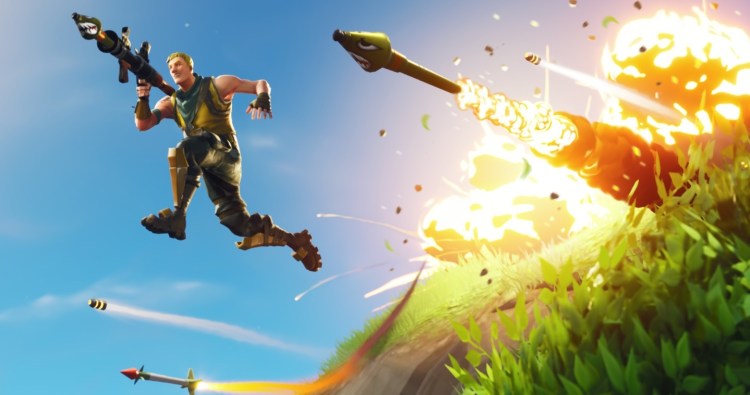Crossplay has become a hot topic among gamers in the past year, and once-siloed platforms have begun to open up their platforms so that players in games such as Fortnite, Rocket League, and Vainglory can play against each other in the same game, even though the players are on different platforms. We held a panel at PAX East to discuss what is driving this trend, and one of them is esports.
For esports to succeed, game publishers have to amass huge audiences, and those players have to be able to play against each other in online tournaments. It’s much easier to amass that large audience if the game can be played competitively across multiple platforms.
But historically, game platform makers haven’t supported crossplay. When Fortnite became hugely popular, Epic Games’ used its Unreal Engine to enable crossplay across the PC, the consoles, and mobile devices, helping Epic grow the game’s reach to more than 250 million players. That motivated platform owners such as Nintendo and Sony to allow crossplay, though Sony appeared to drag its feet.
I moderated a panel included Taehoon Kim, CEO of nWay, publisher of Power Rangers: Battle for the Grid; Daniel Engelhardt, senior vice president of Lionsgate; Reggie Martin, principal product manager at Amazon GameOn; and Sean Keith, head game lead at Tron Arcade. I encouraged speculation during the session, and I engaged in the wildest thinking on crossplay’s implications, but that should not imply that the strategies discussed are actually being used by the companies on the panel.
June 5th: The AI Audit in NYC
Join us next week in NYC to engage with top executive leaders, delving into strategies for auditing AI models to ensure fairness, optimal performance, and ethical compliance across diverse organizations. Secure your attendance for this exclusive invite-only event.
True cross-platform games and cross-platform game characters and assets are on the horizon. We hope you’ll enjoy reading our thoughts on what the future of crossplay and esports could be.
Here’s an edited transcript of our interview. Disclosure: The organizers of the session paid my way to Boston. Our coverage remains objective.
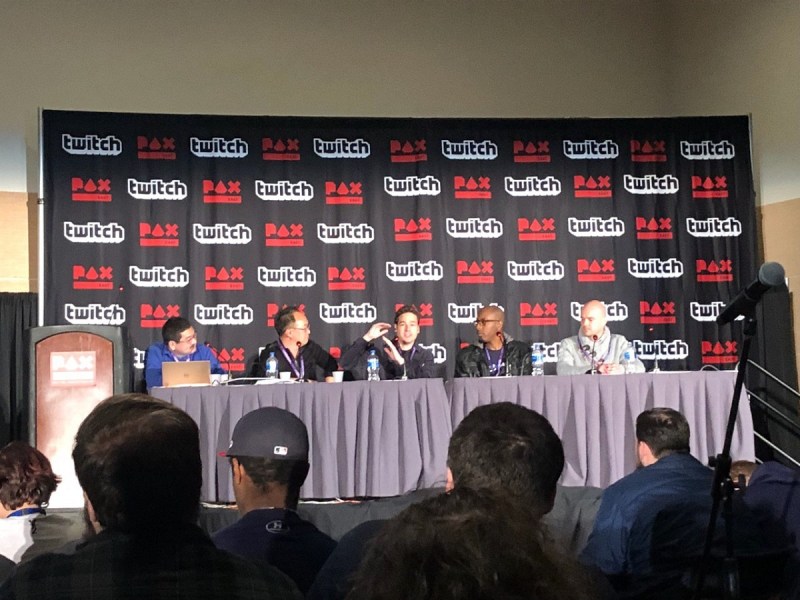
Above: Crossplay panel at PAX East (left to right): Dean Takahasi of Venture Beat, Taehoon Kim of nWay, Daniel Engelhart of Lionsgate, Reggie Martin of Amazon, and Sean Keith of Tron Arcade.
Taehoon Kim: I’m the CEO of nWay Games. We specialize in competitive games, multiplayer games, on mobile, and also crossplay. We make the world’s best Power Rangers game. Our first game was Power Rangers Legacy Wars, which launched two years ago on iOS and Android. A couple of days ago we launched Power Rangers: Battle for the Grid on Nintendo Switch and Xbox. We have PS4 coming next.
Daniel Engelhardt: I help oversee the games business at Lionsgate, the movie studio, as we partner with developers and publishers like nWay to make games based on our properties. We’ve also made some investments in game developers and launched an esports franchise.
Reggie Martin: I’m a product manager for Amazon Game On. That’s a service that allows game developers to bring players together through competition. We enable developers on all platforms, so not only iOS and Android, but across PC, console, AR/VR, everywhere you can play a game and host a competition. You can give away prizes with Game On, and allow Twitch streamers to host games via Twitch and have players go in and join the competition.
Sean Keith: I’m the head game lead at Tron Arcade. Tron is one of the world’s largest blockchains. It has a protocol layer that allows developers to innovate on games and game design and game economies in new and exciting ways. Some of those involve making it easier for players to interact with esports. We’ll hopefully talk about that later today.
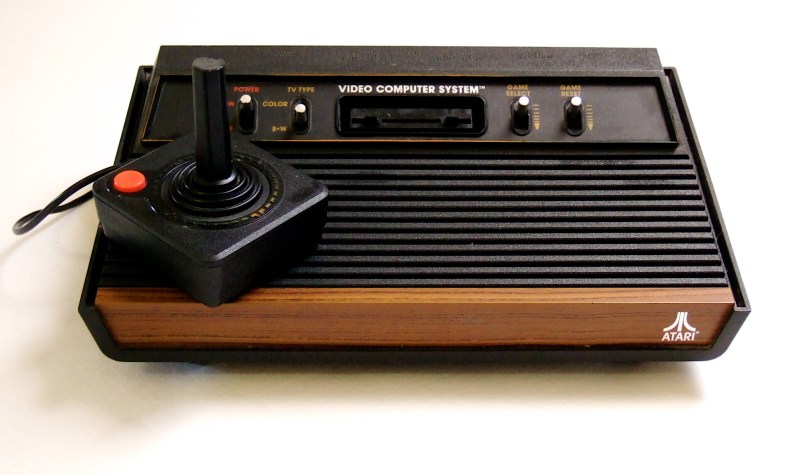
Above: Atari 2600
GamesBeat: It’s an interesting topic. I grew up in the day where there was no expectation of crossplay or cross-platform games at all. You couldn’t play your Atari cartridge on an Intellivision. But the expectation today is very different. There’s a bit of history developing for here and now crossplay. We can credit Fortnite for a lot of that. That tells you just how young actual crossplay really is.
We’ve gone from cross-platform, meaning you can make a game that runs on iOS and also runs on Android, but you couldn’t play between those platforms until Fortnite became so popular. The idea of playing with your friends became even more important. We’ll get started with crossplay here and now. TK, can you tackle where it is now, especially within your own games?
TK: When we first launched Legacy Wars, it was the first fighting game to do crossplay between iOS and Android. That was two years ago, early 2017. We had to do a lot of innovation to make that happen. Now Fortnite has paved the way to where you have one build running on mobile, console, and PC all together. What that enables is, anybody who has access to a game device can get involved in competitive gaming. They’ve also made sure there’s a lot of prize money involved, so competitive gaming is fun to watch and people can make a living as pro gamers. That’s where we are now.
The general trend, I think, the direction we’re going toward, is that everyone will have access to these games. Because the pool of people participating in a single game is getting bigger, game developers will be able to deliver bigger prizing. With things like blockchain, you’ll be able to get paid no matter where you are and what device you’re on. We’ll see games with multiple events within the game every day, smaller payout games, bigger payout games. Besides pro gamers making a lot of money, there will be a bigger pool of people that can make decent money playing video games.
Engelhardt: As TK said, competitive gameplay is going to be more and more accessible, as the distance between PC and mobile gets closer and crossplay takes shape. But also, at the same time, you have Overwatch League and other really big esports franchises being built outside the actual game. You’ll have professional esports being built at a massive scale that we haven’t seen before, but at the same time, you’ll have a competitive community forming around more and more games, relatively robust communities that will be able to generate revenue for publishers and players. That’s only going to continue to drive forward with crossplay becoming more widely available.
Keith: There are a lot of interesting parallels to be drawn between esports and the traditional sports world. The fact that we’re calling it esports now is already a huge jump from when I was a kid, where it was just playing video games with your friends. The whole concept, that playing games can be a sport, it’s created competitive levels where you have the very best players out there, and now it’s trickling down to more local levels, where you see colleges and schools getting involved. You’re seeing scholarships for people to go to college and play esports.
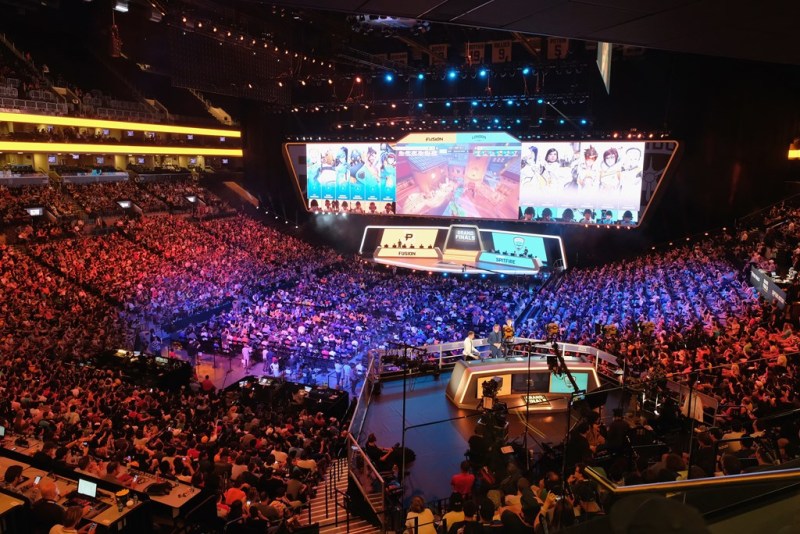
Above: The Overwatch League Grand Finals.
As time goes on, it’s going to grow into a cultural phenomenon in a way it wasn’t before. If you look at the numbers, esports last year pulled in close to a billion dollars. Traditional sports made about $500 billion to $1.3 trillion. There’s a long way to grow. It’s an exciting time to be in the game industry, to be a game player, and to see esports getting larger and more prolific.
Martin: Agreed, it’s a super exciting time to be in the game industry. To continue the sports analogy, soccer is the biggest sport in the world because it’s such an easy game to pick up and play. All you need is a ball. If you want to build a community for gamers, right now we have all these siloed communities. What crossplay opens up is the ability for that community to grow. It’s going to be a huge step forward.
GamesBeat: You can imagine the problem you’d have if one of the best players in the world is a PC player in a game and the other best player in the world is the best on Switch. Which one of them is really the best player? Eventually you want to get there, but you can’t get there if they can’t play against each other. That’s where most of the world is now. TK, what are some games that have actual crossplay today?
TK: Right now it’s not fully there, because one of the biggest platforms out there, Sony, still isn’t fully opening up. They’ve made some exceptions with a handful of games like Fortnite and Rocket League, but they’ve said they have to judge whether they can allow through other games or not. They’re getting a lot of pressure to open up.
GamesBeat: That pressure is coming from gamers. They want to do this now. The interesting thing is — one of our panelists, Kristian Segerstrale, couldn’t make it today. He’s with Super Evil Megacorp, which just launched Vainglory on the PC. Before that, Vainglory was a mobile-first MOBA game, and now you have crossplay between PC players and mobile players in the same games of Vainglory. It would be interesting to know how much of that has happened — how much is still mobile-to-mobile play and how much involves PC players. But you get the sense that people really want to do this. If you make this possible, people are going to play each other across platforms.
TK: People want to play with their friends, and not all of your friends are going to be on the exact same platform as you are. Being able to do that is great. Also, families like to play together. One thing we’ve seen with games like Vainglory and Fortnite is that a whole family may want to play together, but nobody owns four PlayStations. Dad’s going to play on the iPad, one kid is on the PS4, another kid is on his phone. That kind of gameplay is only possible through crossplay.
Martin: Playing with your family is super important, but also, how many of you have watched streamers on Twitch? A fair number, right? People love to play with the streamers they follow, and if you don’t have the exact same equipment as them, you can’t play with them today. With crossplay, suddenly that opens up the whole community. Everyone in chat can play. Everyone can play in a competition, in the same multiplayer session. It makes that experience so much more fun. You can play with anyone in the world, no matter what equipment you’re using. That’s a huge promise.
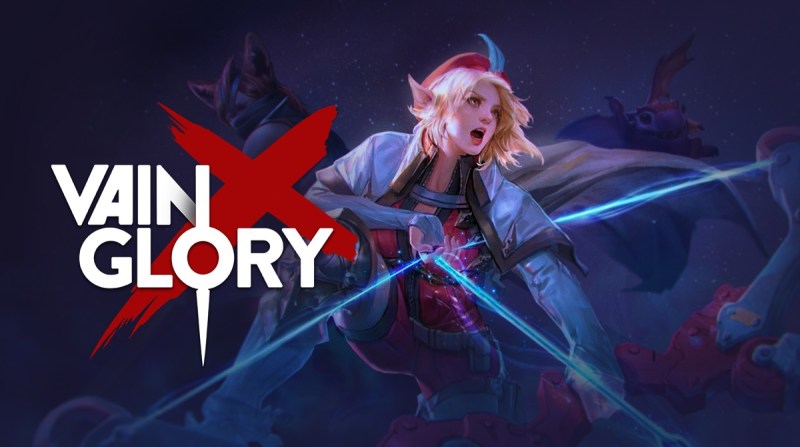
Above: Vainglory is now available on macOS, Steam, and mobile.
Keith: What’s interesting as well, in east Asia, you have a lot of countries where people don’t have PCs. They only play games on their phones. Up to this point, before crossplay, they’ve been forced to play mobile games and only mobile games. Which are great, but if they wanted to play a game like Fortnite, they wouldn’t be able to play outside of something like a gaming cafe.
As crossplay progresses, it’ll democratize, in some senses, esports. Suddenly, players who couldn’t participate in competitive games before now can through their phones. That’s at the grass-roots level. When you get up to the higher levels of competition, if a player is really good on mobile, maybe they’ll get picked up by a team and they’ll transition to PC or another platform. It makes esports more inclusive in ways that weren’t possible before.
GamesBeat: With Vainglory, the easy thing for them was that the game worked well on both mobile and PC. The difference between the players as far as skill level wasn’t that big. In mobile, you’re just tapping the screen, and that translates well into a mouse click. Neither platform has an advantage. If you were having to steer things around the screen of a mobile device, you’d probably have a hard time beating a PC player with a mouse and keyboard.
That makes a big difference as to whether a game is going to go truly crossplay. TK, you were saying that you can detect what a player is using and then matchmake players that way.
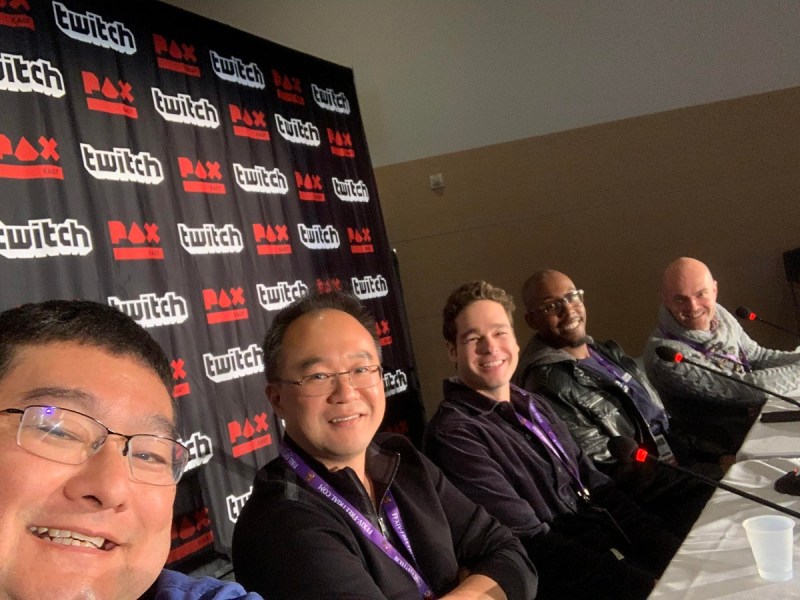
Above: Crossplay panel at PAX East (left to right): Dean Takahasi of Venture Beat, Taehoon Kim of nWay, Daniel Engelhart of Lionsgate, Reggie Martin of Amazon, and Sean Keith of Tron Arcade.
TK: Yeah, there are really good controllers out there for mobile as well. If you want to be really fair, you want to matchmake according to what peripheral someone is using. If someone is using a controller, you match them with another player using a controller, so if I’m using a controller with my mobile device I’m in the same matchmaking pool with console players. If I’m on the PC with keyboard and mouse, I’m in a keyboard and mouse pool. If you want to truly make it fair, that’s a better way to do matchmaking.
Keith: I can talk about how blockchain enables players to participate in esports in a more equitable way. Right now, you have a lot of players all over the world, or in different states, and it’s relatively easy to pay for things with a credit card. If you want to play in a tournament, you can register relatively easily and pay with your card. But in many more parts of the world that’s still not the case, whether it’s because people don’t have access to banks — this is the case in parts of southeast Asia and a lot of Africa — or maybe they just don’t have US dollars. There are lots of pain points for players who want to participate in esports tournaments.
One of the answers that blockchain provides, and specifically cryptocurrency in this case, is that you’re no longer constrained by your lack of access to US dollars. And that’s just to register and participate in tournaments. If you want to get a payout and you don’t have a bank account, or your bank doesn’t do currency conversations, you can’t get that. With blockchain, there will be games coming out in the future where that’s all much more seamless. No matter where you are in the world, you’ll be able to register, participate in a tournament, and take winnings home through the same system. Blockchain creates a lot of efficiencies, and it’ll make for more seamless experiences in ways that are difficult to do using traditional payment technology.
GamesBeat: While blockchain is one thing that can help enable this cross-platform world, one of the challenges is a chicken-and-egg problem. Not many people use a particular cryptocurrency. That has to happen first.
Keith: Blockchain technology for mass use is still relatively new. It kind of blew up in late 2017, so it’s been only a year and a half. We’ll see a lot more development in the coming years — better software, better dApps, decentralized applications, that will bring user adoption up.
You’re right that it is a chicken-and-egg problem. If people aren’t using blockchain and cryptocurrencies, developers won’t make games around them, and if there are no great games then customers won’t come. But I know of several developers that are actively looking at using blockchain technology to enhance their engagement with their players. That’ll happen this year.
Question: Regarding blockchain in different markets, countries like China and Russia have restricted its use, so how would you approach that problem?
Keith: Regulation is an issue. Certain markets, certain countries do have different rulings on how their systems can interact with blockchain. If China says you can’t use cryptocurrency, there’s not much we can do. That said, because the technology is new, a lot of governments are unsure how to approach it. As the technology becomes more mature, it’s up to people in the blockchain space to educate those governments, to work with local governments, to make sure they feel safe allowing their citizens to interact with this technology. That’s on the industry, to move forward on that.
GamesBeat: An argument in favor of blockchain is that the world is changing. If you look at Venezuela right now, their government-issued currency is going through crazy fluctuations. If you’re a player in that country and your currency is going haywire, how do you pay to play online games? People are introducing what they call “stablecoin” cryptocurrencies to deal with that kind of thing. The currency remains stable so it can be used for trade and doing things like playing a multiplayer game. Blockchain can solve some problems that arise from the way currencies fluctuate.
Martin: I’m an advocate of giving people something to trade. If you have goods you can trade in your game, you can start to build a marketplace and build a community around that. For a lot of games, having that community is what keeps that game going on over time. Look at a game like Magic: The Gathering. People have invested a ton of money in cards, and trading those cards in a larger metagame is a huge part of why that community is so vibrant. If we can help players create those communities, we’ll see that push game developers and platform holders to allow them to use technologies like blockchain and to work across platforms.
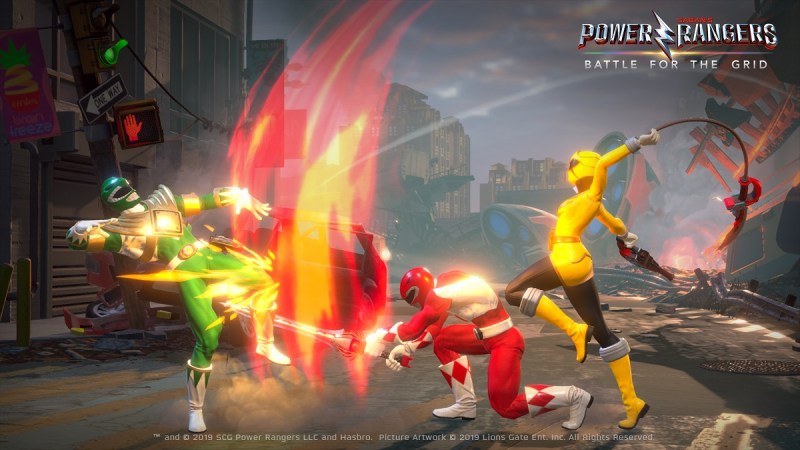
Above: Power Rangers: Battle for the Grid.
GamesBeat: There’s another area of, say, theoretical crossplay we can all speculate around. Some interesting things happened just in the last week, where Apple announced Apple Arcade, where you’ll be able to pick up your saved game on any Apple device, whether it’s iPhone, iPad, Apple TV, or Mac. Right now, iOS and Mac are on separate binaries, so I’m not sure how Apple is going to achieve this — it’s technically not an easy problem, which is why they haven’t done this before — but they promise that by the time they launch the subscription service for Apple Arcade in the fall, you’ll be able to do that. Crossplay within the Apple world will be possible.
Of course, the impossible crossplay would be to play between Apple devices and those outside of Apple. But what do you think this development could lead to? We also have Google’s announcement of Stadia in this past week.
TK: I think Apple is trying to advance more around their business model. Because they’re mainly mobile-focused right now, and most mobile games are free-to-play with monetization tactics that may not be too healthy for the industry in the long run, that may be what they’re reacting to.
GamesBeat: So subscription may be a healthier model for games than free-to-play or premium.
TK: I think so. A lot of games have monetization tactics that just aren’t working in the long run. Gamers have reacted badly to them. Having one subscription for games, even on mobile, that are built around experiences rather than built around monetization, can be good for the mobile industry.
As far as Google, though, I think that’s a true play for crossplay, where because you’re being streamed the content, it’s going to be truly platform-agnostic. As long as you have a window onto computing and the internet, you’ll be able to play the same build of the same game as anyone else.
Martin: The exciting thing about all of this technology that’s coming out is that it allows people to come together. All of us like to connect, and all of us like to compete as well. I think that’s why we’ve seen so many games add competition to what they’re offering. They see people take more interest in the IP. They see engagement and retention go up. It’s how we’re wired, to compete with each other.
These new technologies, whether it’s streaming services or other kinds of cross-platform play, are going to allow more players to play together. In a multiplayer game where you have a small pool of players, you’re going to have to wait a long time to get a match with somebody, or end up in a match with someone who’s ranked far above you, which isn’t much fun at all. Crossplay is inherently more fun, which I think is why we’re all here.
Keith: Piggybacking off that idea, it’s not only competitive, but it’s also very social. We’re all social creatures. To be social in a game–games are no longer just about playing a game, interacting with that game experience. They’re also about interacting with your friends. Some games are solely about interacting with your friends. Having cross-platform experiences on different devices will allow people to socialize more as well, regardless of whether you’re at home on your computer or outside on a tablet or a phone.
One of the interesting parts about crossplay is that it will drive games to be more social. It’ll enable game developers to create more social experiences. Maybe things like what happened in Fortnite, with the Marshmello concert, will become even more prevalent. If I’m outside, maybe I want to log into my game not to play the game itself — not to actually play Fortnite — but to do something social like see a concert.
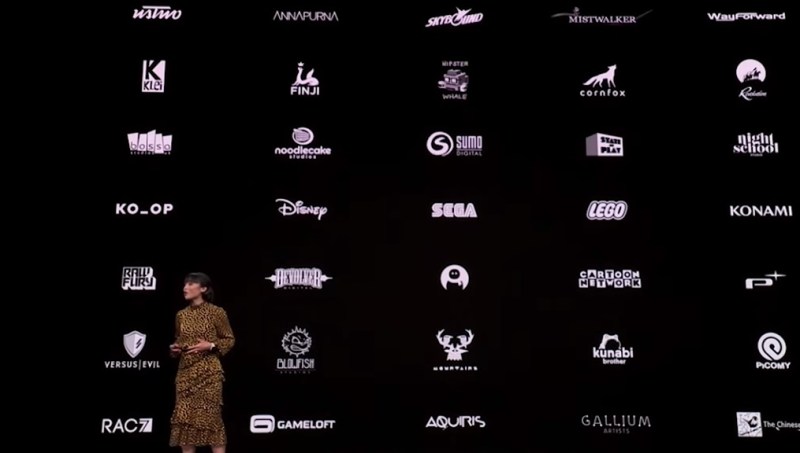
Above: Developers working on Apple Arcade games.
GamesBeat: There’s a business-level chess game happening here around crossplay. Gamers may wonder why companies do some of the things they do. Apple this week said that the games appearing on Apple Arcade will appear nowhere else. Why would Apple want to do that?
Some things aren’t so clear, but there are threats to Apple’s business in some ways. Why is Apple doing entertainment services at all, for TV shows and games? Why is it funding them and doing all of this stuff on its own? Because there are threats that can take control of that kind of thing out of Apple’s hands. Disney has decided to pull its movies out of Netflix and put them on a Disney streaming service.
The advent of Google Stadia is interesting as well, because it’s a cloud gaming platform where the game resides in a data center. You can play it anywhere, on a PC or a console or anything else. You could play it on an Apple device, but if you’re only subscribing to Google Stadia, paying $10 a month or whatever they end up charging, you won’t pay anything to Apple. That’s where Apple is waking up and saying, “We don’t really want that to happen. We have to captivate the gamer in a different way.” That, I think, is why Apple Arcade is happening.
The interesting thing about crossplay, then, is that it comes into this picture when other technologies like cloud gaming are also arriving to stir up the status quo in different ways.
Question: We’ve had some examples of crossplay going back a long time. You had Shadowrun across Xbox and PC, or Phantasy Star Online, or Final Fantasy XI. Even Uno was playable on both 360 and PC. What’s special about how this is happening now? It’s been happening since the 360 era, but nothing really took off.
GamesBeat: One thing we haven’t really talked about yet is how when the consoles moved over to x86 architectures, running on Intel/AMD processors, the PC and the console became quite close together internally. Technically speaking, it’s not that hard anymore to make games run on different platforms. Those platforms are becoming fairly comparable in their capabilities. The thing that’s bad for crossplay is when you have a very powerful device next to a very weak device and you try to have people on both play against each other. That just doesn’t work. But with devices getting closer together–mobile devices are even growing up and becoming fairly powerful themselves. That’s also making an impact.
TK: Also, connecting crossplay to the more recent notion of games as a service is especially powerful. When you’re running a game as a service, you want people to be able to access that game from any device. Fortnite is one of the best examples right now. Being able to access that on any device — mobile, Switch, PC, console — that’s very important.
Question: When it comes to the difference between console, PC, and mobile, there’s a big skill gap. I feel like that has a lot to do with equipment and what’s available to the player in terms of resolution and framerate and things like that. How is that going to affect crossplay? How can technology create a level playing field for people when it comes to something as simple as running a game?
TK: When we were building Battle for the Grid, we had that in mind. We had to make sure we could keep the game locked at 60 frames per second on all platforms. We had to push pretty hard to do that on the Switch, which isn’t as powerful. It means developers are going to have to have some talent at optimization, using fewer polygons or effects, things like that, while still making something visually comparable. You’ll have to be good at that.
Another consideration is matchmaking around peripherals. Having that factored in to your servers and matchmaking is going to be important, depending on what type of controls you’re using. If you’re using a controller, you need to make sure matchmaking puts you together with other players who are doing the same.
Question: I was going to bring that up. Say you’re playing with your friends who are console, but you also have a friend who’s on PC. Are you not going to be able to play with them because they’re not fitting into the algorithm for matchmaking?
TK: What you do is you group people together. For an FPS, a keyboard and mouse is generally the best option, controllers are next, and touch screens are third. If your group is mixed, then you matchmake depending on the highest common denominator. If the group includes a keyboard and mouse, then you matchmake that with group with a keyboard and mouse group.
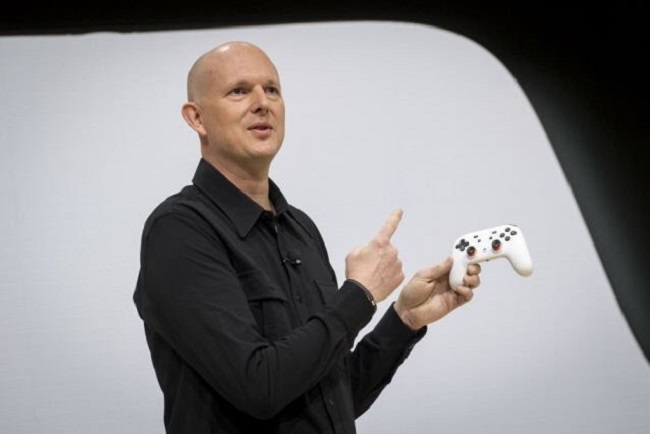
Above: Phil Harrison shows off the Google Stadia game controller.
GamesBeat: It was interesting to see that Razer just recently came out with a keyboard and mouse for the Xbox One. That kind of matchmaking could happen now, with a console player matching up exactly against a keyboard and mouse player on the PC.
Question: There’s a lot of technical skill around getting games to work across platforms, but I was hoping you could also talk a bit about how design of games might have to possibly change for them to be viable candidates for crossplay. Obviously mobile has a vastly different audience than PC or console. How would you evaluate something around whether you it would work for crossplay, and how would you adapt its design?
TK: Developers who have experience making mobile games are going to have an advantage here. Vainglory is a good example. They’ve already made it work with a touch screen. Taking that and adapting it to a PC interface is easy. Fortnite’s approach is different, obviously. Mobile is kind of ancillary to the experience. You’re not going to play your most important matches on mobile. But if you’re waiting in line somewhere, if you have some time, you might as well play a casual match.
Martin: Developers who have that in mind when they start a game, also, are going to be a lot better off than if they build a game and then decide later on that they’re going to port it to mobile. If you think about the history of web development, everyone was on PC first, and then for the first few years of the mobile web you had all these websites that looked horrible on your mobile phone. Now people have studied mobile web design and they can plan ahead for making the best experience across multiple platforms.
Engelhardt: Certain games work really well in the kind of short-term setting on mobile, where you might be playing during the two minutes that you spend waiting in line for something. Not everything is going to lend itself to that. But to your point, some developers are going to have a good idea of how to create something on mobile that’s additive to the PC and console experience. There will be examples like Fortnite where there’s a different value in playing across platforms. But the folks who understand mobile and have that in mind as they’re going forward–that broadens the overall experience, even if you’re having a different kind of session on the mobile side.
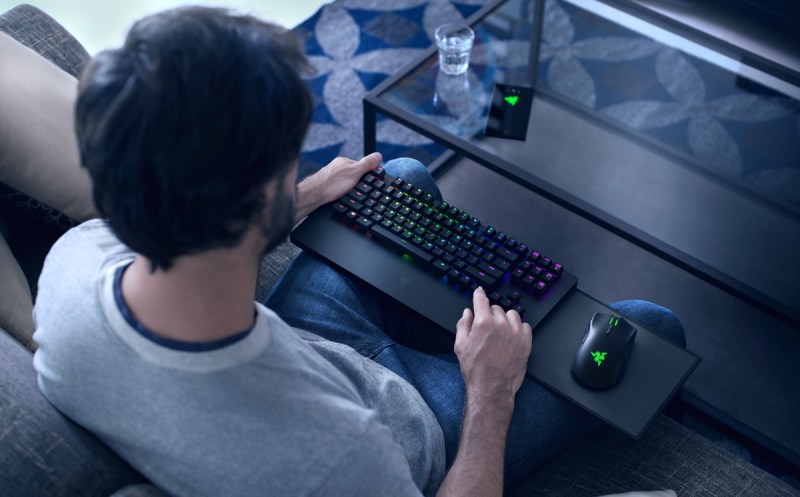
Above: Razer Turret is a mouse and keyboard for the Xbox One.
GamesBeat: Valve mentioned last week that Counter-Strike requires a response time between 30 and 60 milliseconds. That kind of game is not going to be great for crossplay, especially on mobile devices, where you’ll have slower response from graphics and interfaces. But if you look at games like World of Tanks or World of Warships, there’s no reason why you can’t have them work across platforms and be fair at the same time. The twitch factor, how fast that response time has to be, is definitely going to affect whether crossplay is a possibility.
Keith: One thing that’s also important is that a lot of game developers out there would love to create an experience that could be played on mobile and PC and console, but it’s most important to hit one of those targets really well. The game has to be a good experience on a single platform first before it can have a chance across multiple different platforms.
I used to work in China for Chinese game companies. They would try to create games from the ground up to be played on both PC and mobile, and they found out that players didn’t like those experiences, because they tried to be so broad. The reaction wasn’t very good. To TK’s point, for a game to be a really good crossplay game, it’s probably easier to start on mobile, because it’s easier to adapt mobile gameplay to PC gameplay with similar fidelity. Doing something like Fortnite–they wanted to improve the stickiness of the experience and give players the opportunity to play Fortnite on their phones. In my personal judgment, the game experience isn’t as good on mobile, but there’s not much you can do about that.
GamesBeat: Another way to look at it is through genres, and whether a genre exists across different platforms. When you look at realtime strategy, it’s pretty much tied to the PC. We all understand why you can’t easily play an RTS game with a controller. That’s not a good candidate for crossplay certainly.
Question: Do you see crossplay evolving to a point where many esports games are going to share a common wallet, where you can pool all your currency there very easily, or you think companies will stay more individualized? You have to buy Apex Legends currency to get into anything there, and so on.
TK: Everyone’s going to have Tron. [laughs]
Keith: Shameless plug! It’s interesting. It’s definitely to the benefit of developers to create a wallet that keeps players in their ecosystem. That’s one of the biggest issues. Players love to take digital currency between different platforms and different games, but developers don’t want that, because they want you to buy their in-game currency.
One thing that will be available later on for some games to take advantage of, and this touches on blockchain a bit, is that digital item ownership will be good for players. Right now, when you agree to the terms of service for a game, you’re basically licensing the right to play the game. You don’t own the game or anything in it. With blockchain and creating digital assets that are tokenized, players will be able to own their items. That opens up a lot of interesting possibilities for going to the marketplace and selling your items if you want to get out of a game, or even finding items that people want to buy while you play and taking them into the marketplace.
As far as having wallets that are interoperable between games, I think we’re still a ways away. Again, until developers feel that they’re incentivized to do that, it’s going to be a tough sell to allow your premium currency to be taken away into another game. But with blockchain that is going to be possible.
TK: I love the idea of a wallet that’s platform-agnostic, that has all your money and all your digital ownership in there. It would be great to be able to use that wallet to exchange currency from game to game. I could go into a game regardless of what platform, whether it’s mobile or PC, play that game, win something, and take that back to play with in another game.
Keith: With cryptocurrency that is possible. If a game makes its premium currency as a token, then players would be able to sell that for other tokens. But when you look at platforms like Apple and Google, they lock you into terms of service and payment systems. It’s very difficult to integrate blockchain-based token economies into games there.
In the future I think we will see blockchain games with token economies, though. It’ll be interesting, over the next few years, to see games tokenizing their in-game economies and allowing players to sell their currencies for other game currencies if they want to.
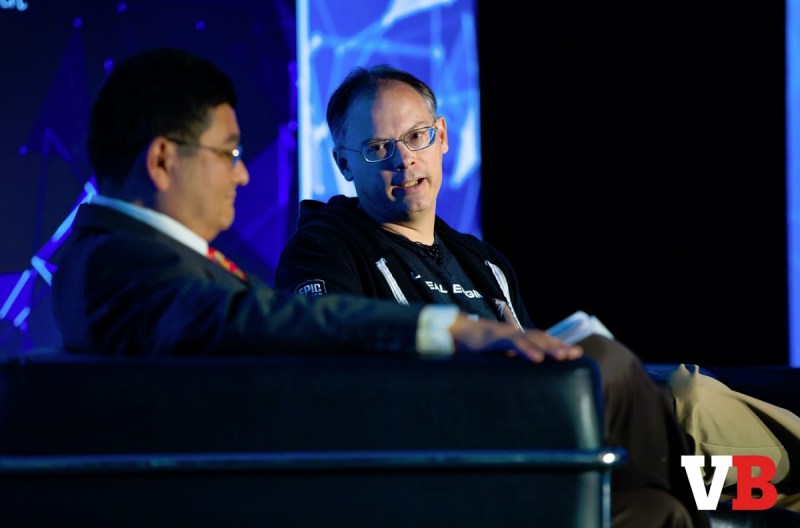
Above: Tim Sweeney, CEO of Epic Games, wants the Metaverse to happen.
GamesBeat: There is a science-fiction world that we’re heading toward, which started with Snow Crash and the metaverse, (the virtual world envisioned by Neal Stephenson in his 1997 novel Snow Crash), and then everybody here I’m sure is familiar with Ready Player One. In those stories you saw people going from one experience to another. I’m not the only one who’s interested in this. Eventually there’s a kind of metagame that people are interested in building.
Right now people want you to generally play their own games in their own worlds and not mix all of these worlds together. But at some point everybody becomes more interested in this idea of a metagame across many games, a metaverse. Tim Sweeney at Epic Games has thought about this a whole lot. I’ve interviewed him a number of times where he’s mentioned these things, and he’s talked about how things like crossplay and blockchain are essential stepping stones on the way to the kind of world he’d like to see happen.
That only happens if there aren’t insurmountable barriers between these worlds. Blockchain, for example, is a way to break them down. If you let somebody buy or create a character in one world and you can take it and verify it’s a character you own through blockchain, you can take it into another world. Then you’re halfway to this idea of the metaverse.
Keith: That already exists in some smaller blockchain games right now. Collaborations between developers–if you have your CryptoKittie you can take that with you into another game experience. But seeing something like Apex and Fortnite exchanging characters, we’re still a ways away from that.
Martin: The other part of that is, keeping track of your wallet and the things you own also limits your ability to cheat.
Keith: One thing we’ll be able to see is the history of items. If items are tied to a blockchain, developers can determine which players own what items. Your favorite esports player might have a certain item and you’ll be able to see that they won using that item.
GamesBeat: It becomes a kind of souvenir at that point, one of a kind. How much would someone pay for that?
Keith: If you go on eBay and search for autographed baseballs, people pay thousands of dollars for something signed by their favorite player. Something like that could be doable with blockchain item histories.
Question: Do you think we’ll ever get to a point where crossplay really affects the top echelons in esports? Or do you think we’re more likely to see a world where there’s, say, a Fortnite mobile league, a Fortnite Xbox league, and a PC league?
Engelhardt: We’re going to see mobile heat up in the context of esports. It’ll be pretty hard to set up an environment where someone on a mobile phone can compete with someone on PC at a high professional level, because once you get to that stage, games have to be perfectly balanced. But where cross-platform play becomes more interesting in my opinion is with more local communities, competitive communities that start forming around these games and make it more accessible for friends to compete with each other. That can become more and more competitive over time.
Martin: I agree. You’ll have things like weight classes, so to speak. You’ll have a separate track for different platforms. But at that community level everyone is building together. You can have people playing together and also have separate tracks, depending on where you sit.
GamesBeat: Some rules separating players makes some sense. The analogy would be, you don’t get to bring your own kind of football to a pro football game. It’s a standard thing.
Keith: It also depends on what kinds of games we’re talking about. Right now we’re probably thinking of games like Overwatch or Fortnite. But Hearthstone, that experience is pretty equitable across platforms. Even TK’s fighting game, a game like that could be relatively equitable as well. It just depends on what kind of game you’re talking about. Some will be equal across different platforms.

Above: Fortnite.
Question: Talking about the barriers around going into esports, there’s the amount of money that you can make there, but that weighs against the how much time has to be put into it. Do you think esports will eventually get to a point where players will start at a young age and parents will let them practice their games?
TK: It’s already happening in Fortnite right now. You’ve got Fortnite careers.
Question: Right, but for the most part parents don’t look at that as a realistic career route to take. When do you think it’ll become a saleable business practice for an esports team to recruit kids at a young age and start that whole process where eventually they can be a top player?
Martin: Like he said, I think that’s already happening. You have companies partnering with high schools to run sanctioned esports events. You’ll have different teams going out to try to make things happen with schools at earlier levels. From a cultural perspective, my parents would have said, “Get away from those video games.” But people are getting scholarships to go to college now. The seeds are being sown. I don’t know if it’ll be a year or five years or 15 years before it’s normal for parents to take their kids to esports practice after school, but I can see it coming.
GamesBeat: It’s hard to be a parent today and listen to advice coming from these directions. Do I want my kid to read these books, or do I want my kid to train on these video games in the hopes of becoming an esports star someday?
There are some very interesting changes happening in society in general. Who ever thought that people would be making a living as streamers five years ago? Ninja made more than $10 million last year doing what he does. There’s a long tail that will eventually emerge, where celebrities won’t be the only people who make money playing video games. A lot of normal people will be able to make a more normal living [in a leisure economy].
This notion that AI is coming along to change society–we have a lot of predictions out there saying things like it will eliminate a third of all existing jobs, including even computer science jobs. You could say, “Hey, kid, programming is the thing you have to learn to do now,” but eventually AI will put that out of business. So if AI eliminates a third of all jobs, what jobs will still be there when kids today grow up? I’m pretty sure esports will still be a good job to have in the future. We’re going to totally screw up parents because we have no idea when that moment is going to come, but I think it’s going to come.
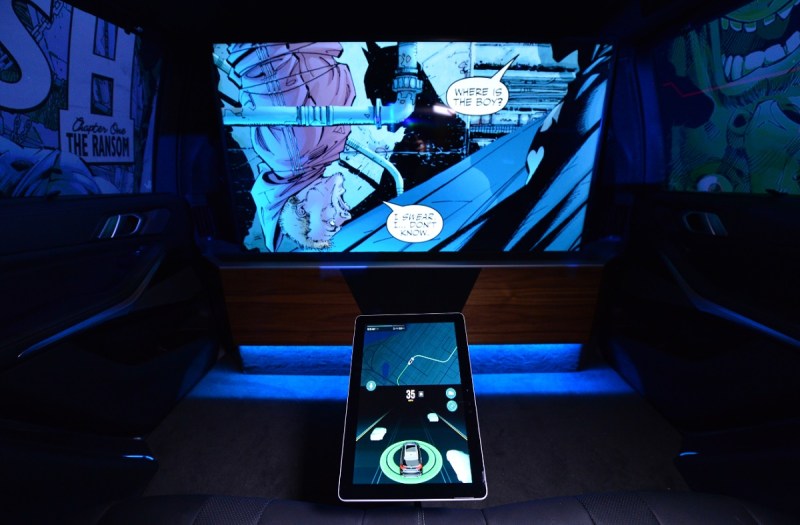
Above: Intel and Warner Bros. are figuring out car entertainment of the future.
Question: Where do you see competitive gamers in the future as crossplay becomes more normal? Smite just introduced crossplay, and you can play with other people unless you’re in a ranked game, where it locks you to a platform. But as that becomes more normal, do you think the competitive mindset might evolve to–you have a controller for more mainstream competition, and then you get to a point where competitive teams could have one guy on mouse and keyboard and one guy on a controller. Is that possible? Or do you think that no matter what, it’s going to be locked per platform?
TK: I think crossplay is going to widen the pool. The reason why the soccer talent in South America is so good is because you have more people playing. With crossplay, you get more people into the funnel, and that means you’re going to have better players and bigger payouts. Ultimately it’ll be good for the whole ecosystem.
Martin: I think it’s important to distinguish between the professional level of esports, where you have Overwatch League and so on with professionals competing at a top level, and then the competitive communities that form around these games that are competitive, but by no means competing at a professional level, where you have a perfect balance to all the hardware and every single variable eliminated to keep anyone from having an advantage. Crossplay increases and democratizes accessibility at that community level, but at some point, once you get to that really professional tournament and league structure, there has to be more balance.
Keith: You raise an interesting point on the evolution of these games. If game developers are going to evolve to producing games that are genuinely cross-platform, where the experience is the same, players will also evolve toward the same purpose. Now that you have a keyboard and mouse for Xbox One, everyone who wants to play competitively will go out and buy those peripherals that allow them to be competitive, no matter what device they’re using. If I can play with people on PC from my console, I’m going to gear up so I can do that.

Above: Rocket League
Question: A few months ago I just started a local Rocket League group, where we have monthly events. We have almost 200 players, and we’ve run into the issue of Switch players versus PS4 players versus PC players, especially when people want to move to a new platform to gain an advantage. Do you think that esports industry should look at a different licensing model for players who want to play the same game on multiple platforms? And should they force people to face a level playing field between platforms?
Keith: Really, I think it’s down to the platforms on this one. Game developers make a profit when you buy games across multiple platforms, but the platforms themselves are probably not willing–let’s say you buy it on Xbox, and then PlayStation wants a cut of that revenue too. If they allow the game to come over through cross-buy, they’re providing all that R&D, all the stuff they went through to create the PlayStation experience, and they’re making no money from that sale. In a perfect world the license would be transferable across platforms, but from an economic standpoint, from a business standpoint, it’s probably going to be a tough sell.
GamesBeat: But if Sony runs into problems with players, and players start demanding that you enter into this crossplay world or they’re not going to play on your platform, that’s a different equation. Now they have to calculate whether they’ll actually lose customers through not being as cross-platform as the other guys.
Engelhardt: The other interesting question around whether this will impact the way games are designed is how free-to-play figures in. Obviously a free-to-play game has an advantage in that type of environment. In the long term, as cross-platform becomes more expected, that’s going to affect how we design our games from go.
Question: With consoles moving to x86 and becoming more alike under the hood, platforms have had to find more ways to incentivize people to move toward one platform or the other. With crossplay, you lose even more of that control. On the one hand, could crossplay lead to a downsizing of the number of consoles and devices as we gravitate toward fewer platforms? Or, on the flip side, could crossplay allow developers to become more agnostic and expand out the number of possibilities in terms of platforms that are available? Looking into the future, do you think we see crossplay causing a contraction in the number of platforms, especially in spaces like consoles? Or do you think we’ll see a growth in the number of platforms available to game on?
GamesBeat: I think the future is full of just making games more accessible on more devices. Some games will go across all devices, and they’ll be the most successful. Angry Birds is already on 4 billion devices, and they could conceivably get to the rest of the world. Whatever force pushes in that direction, making games more accessible, that’s going to happen and that’s going to be a good thing. If you can reach everyone in the world on one device, we’ll only need one device.
